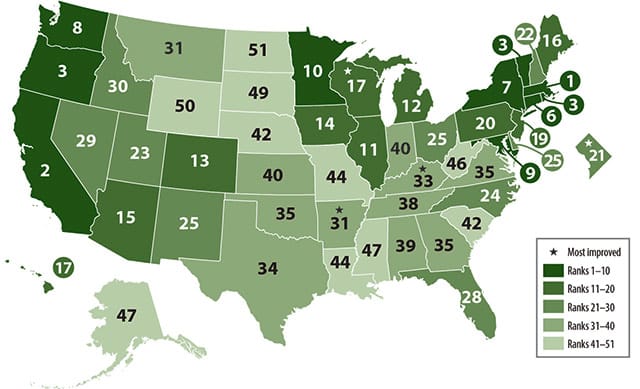Massachusetts has topped the ACEEE’s annual energy efficiency scorecard for the fourth year in a row.
On October 21, 2014, the American Council for an Energy Efficient Economy (ACEEE) released the eighth edition of its State Energy Efficiency Scorecard, which ranks states on their energy efficiency policy and program efforts and recommends measures to improve performance. The scorecard highlights that states continue to ramp up their energy efficiency commitments. The top 10 energy-efficient states are Massachusetts, California, Rhode Island, Oregon, Vermont, Connecticut, New York, Washington, Maryland, and Minnesota. Rhode Island, Oregon, and Vermont tied for the third position. Rhode Island entered the top-five tier for the first time.
Among the key findings, Massachusetts retained the top position for the fourth consecutive year, after surpassing California in 2011. ACEEE attributed Massachusetts’ achievement to its continued efforts under the 2008 Green Communities Act which has spurred energy efficiency investments through increasing annual energy efficiency requirements for utilities. Rhode Island, Massachusetts, and Vermont were the leading states for utility-sector programs. California and New York were the leaders in energy-efficient transportation policies. California topped the building energy codes and compliance category.
The four most-improved states were Arkansas, District of Columbia, Kentucky, and Wisconsin. The five states most in need of improvement are North Dakota, Wyoming, South Dakota, Mississippi, and Alaska. For the first time, ACEEE assessed U.S. territories Puerto Rico, Guam, and the U.S. Virgin Islands – not included in the general rankings – which have taken measures to update building energy codes though they have not made significant energy efficiency investments in other sectors.
According to the scorecard report, 24 states continue to enforce and adequately fund Energy Efficiency Resource Standard (EERS) programs that spur investments in utility-sector energy efficiency. States with strong savings targets include Arizona, Massachusetts, and Rhode Island. A total of 23 states fell in the rankings due to changes in their performance and ACEEE’s methodology. Indiana (#40) dropped the furthest, by 13 positions, due in part to legislators’ decision to roll back its EERS. Ohio (#25) – faced with a similar decision – dropped by seven positions.
Total 2013 budgets for electricity efficiency programs and natural gas programs were $6.3B and $1.4B, respectively. The scorecard reported total electricity savings of approximately 24.4 million megawatt-hours in 2013, a seven percent increase over 2011 savings. It reported gas savings of 276 million therms in 2013, a 19 percent increase over 2011.
The ACEEE scorecard considers programs and policies in six areas – utility and public benefits, transportation, building energy codes and compliance, combined heat and power (CHP), state government-led initiatives, and appliance and equipment standards. Energy efficiency strategies outlined in the scorecard include:
- — Establishing and funding EERS or similar energy savings target
- — Adopting updated, more stringent building codes, improving code compliance, and involving program administrators in code support
- — Adopting stringent tailpipe emission standards and setting quantitative targets to reduce vehicle-miles travelled
- — Treating CHP as an energy efficiency resource equivalent to other energy efficiency forms
- — Expanding state-led efforts and making them visible
Like what you’re reading? Click below for a free trial of EnerKnol Research!





